Other pages on this Web site:
[ Peace
Challenge 2001 ]
[ A Million
Cranes for Peace by the Year 2000 ]
[ Network
Participants ]
[ Places
to Send Paper Cranes ]
[ News Update]
[ Peace Links and Resources
]
[ Ideas and Inspirations
]
[ Photographs of Hiroshima
Peace Park ]
[ Peace Pix ]
[ Peace Symbols ]
[ Peace Talks - Favourite
Quotes ]
[ Peace Exchange
with Hakushima ]
[ Crane Lore ]
[ Historical Background
]
[ Site Map ]
![]() [Thousand Cranes
Peace Network Home page ]
[Thousand Cranes
Peace Network Home page ]
Every year many thousands of people around the world fold paper cranes as an expression of hope for a world at peace, where non-violent means are used to resolve conflicts, and where people can live without fear. For most of these people, the origin of the paper crane as a symbol of peace probably lies with the story of Sadako Sasaki.
Sadako was just two years old when the atomic bomb was dropped on Hiroshima. While she suffered no immediate injury, the effects of her exposure caught up with her some ten years later and she fought a courageous battle with leukaemia.
During her treatment she began to fold a thousand paper cranes (senbazuru) so that her wish for good health would come true. She died before completing her task. Her fellow students folded the remainder of the thousand cranes which were buried with her.
Sadako’s courage and faith inspired her friends, and students from across the world, to raise money for a memorial to the children who were innocent victims of the atomic bomb.
Each year children and adults from all over
the world fold a thousand paper cranes to be taken to the Children’s Monument
in the Peace Park in Hiroshima.
The cranes are placed at the foot of the monument
where the inscription reads:
‘This is our cry. This is our prayer. Peace
in the world.’
Following this practice, paper cranes are now sent to a number of other peace parks and monuments around the world. There are also opportunities to send just one folded crane. Whether one or a thousand, all are folded with the same wish for peace.
You can find out more about Sadako's story through
links from our pages of
Peace Links and Resources.
You can see some photos of Sadako at our Peace Pix - Sadako page.
And you can find out why cranes are a symbol
of peace from our Crane Lore page.
Folding instructions:
You can access crane folding instructions
through some of the contacts listed on our Peace Links and Resources pages.
Some of these are Web-based and you can see which one best suits your
needs.
If you want print-based instructions, try those from Informed Democracy at:
If you are working with younger folders you
may prefer a simpler pattern such as that for Origami Peace Doves
from Peace Pals.
Time:
With only a little practice, each crane can
be folded in less than three (or even two!) minutes.
Helping hands:
Anyone from about 9 or 10 years old can master
this quickly - and it's a great family activity!
Paper:
For really spectacular cranes, wonderful patterns
and colours of origami paper can be purchased from stationers or through
specialist origami suppliers (see some contacts on our Peace Links and Resources pages).
Colourful (but not always colour-fast) medium sized craft squares from a discount stationer cost about $20AUS for a thousand, but think about buying larger squares and having them cut down to size by a friendly printer, as this can reduce the cost to less than $8 per thousand.
Just about any colourful paper can be used,
so if your budget is very limited and/or if you want to 'do your bit' for
re-using and recycling, offcuts of wrapping paper or even high quality advertising
brochures will generally take a good sharp fold and will look great.
|
We made these cranes from 15cm (6ins) squares of discarded Christmas wrapping paper. |
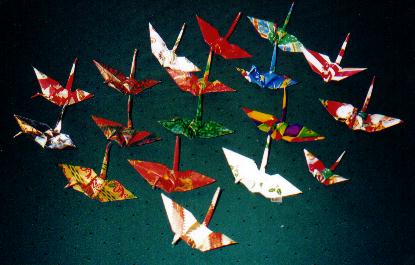
|
The size of square you should use depends on what you intend to do with your cranes:
Presentation:
You have many possibilities for arranging or presenting your cranes:
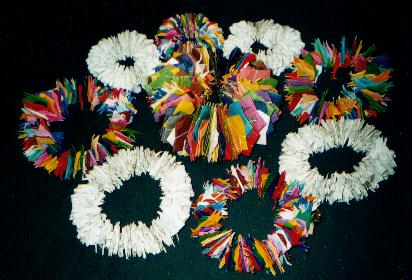
|
These rings of cranes were made
by Genevieve Pung of Singapore. The largest ring is about 20cm (8ins) in diameter. All the cranes are 'wings up' - they pack very well for transport. |
| Our family made this thousand
by threading 40 strands of 25 cranes ('wings up'), always in the same colour sequence, on fishing line. The papers were 10cm (4ins) square, and each strand ended up about 55cm (22 ins) long, which is quite compact for transport. We chose to make these as two garlands of 500 side-by-side but they could just as easily be made with 20 strands of 50 each by repeating the colour sequence. |
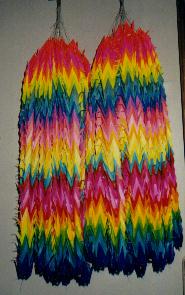
|
To see a range of other examples of finished cranes:
Hanging material:
If you are making garlands of cranes, you
can thread them on wool, cotton or fishing line, using a needle to pass
it through the base of each crane and out the pointed top of the back.
Secure both the base and the uppermost crane
with part of a match, toothpick, bead or similar.
Knot a loop in the top of each strand so that
they hang to the same length.
If making rings of cranes, use a needle to pass the line through the side of each crane, forming them into a ring of whatever size you want.
If you wish to make a mobile of cranes you will also need pieces of wire or lightweight wood.
If you have lots of room for garlands (and you don't need to transport them), a spacer between each crane (such as a bead or a cut section of colourful drinking straw) will expose more of each crane's colours.
Adding messages:
Consider attaching a message to your garland, ring or mobile of
cranes or to each individual crane. You can:
If transporting your cranes to another place, consider a strip saying
where the cranes have migrated from and providing an overall message or
wish.
Any time is a good time to be folding, but lots of people like to set a goal to finish their cranes by a significant date. Possibilities include:
Others choose a topical focus to spur themselves on to fold cranes
as a wish for peace - unfortunately we are never free of such disturbing
conflicts.
Please be aware of the symbolic importance of sending your cranes to other countries - Sadako said of her cranes :
You could send your cranes to a Peace Park or Monument overseas.
For some contact addresses please visit the page Places to Send Paper Cranes.
Some projects donate their cranes to brighten the lives of residents and patients in nursing homes or hospitals, especially those treating leukaemia or cancer, thus developing a different sort of link to the Sadako story.
How do we dispose of cranes once they are finished?
Last modified 27 September 2006
 Back to the Thousand Cranes
Peace Network Home Page
Back to the Thousand Cranes
Peace Network Home Page |
site revisions at the News Update pages |
any of our pages via the Site Map |
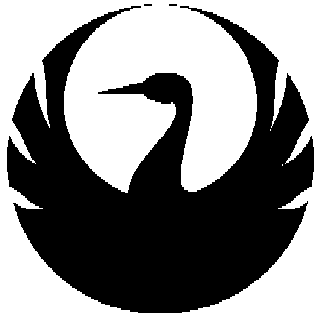 Join the network
Join the network to fold paper cranes for Peace Challenge 2001 |
A Million Paper Cranes for Peace by the Year 2000 |
Network Participants |

See what others are doing at our galleries of Ideas and Inspirations |
for your cranes at Places to Send Paper Cranes |
 Take a brief tour with our
Take a brief tour with our Photographs of Hiroshima Peace Park |
Cross to our Peace Links and Resourcespages |
at our Peace Talks pages |
in many cultures at our Peace Symbols page |

Peace Exchange with Hakushima Elementary School in Hiroshima |
at our Peace Pix pages |
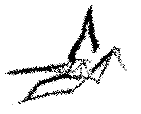
|
For what's behind the network and its projects try Historical background |
 Find out more about
Find out more about the world of wild cranes at Crane Lore |